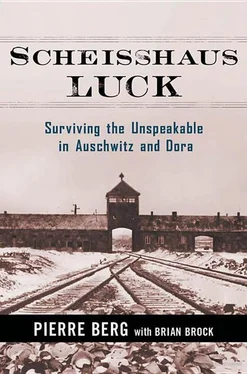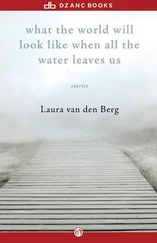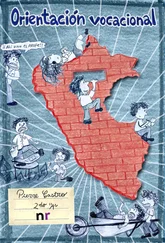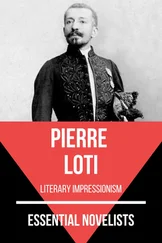6. Steinberg, Speak You Also ; White, “’Even in Auschwitz… Humanity Could Prevail’: British POWs and Jewish Concentration-Camp Inmates at IG Auschwitz, 1943–1945,” HGS 15:2 (Fall 2001): 266–295.
7. For the nationality figures, see Michael Neufeld, “Introduction: Mittelbau-Dora—Secret Weapons and Slave Labor,” in Beón, Planet Dora , p. xx; idem, “Foreword,” in Sellier, A History of the Dora Camp , p. x; for the history of Dora, see also Joachim Neander, Das Konzentrationslager Mittelbau in der Endphase der NS-Diktatur: Zur Geschichte des letzten im “Dritten Reich” gegründeten selbständigen Konzentrationslagers unter besonderer Berücksichtigung seiner Auflösun-gsphase (Clausthal-Zellerfeld: Papierflieger, 1997); and most importantly Jens-Christian Wagner, Produktion des Todes: Das KZ Mittelbau-Dora , ed. Stiftung von der Gedenkstätten Buchenwald und Mittelbau-Dora (Göttingen: Wallstein Verlag, 2001).
8. Pierre Berg, “Odyssey of a Pajama” (unpub. MSS, 1953); Berg, telephone interview, 13 June 2004.
9. Elie Wiesel, Night , trans. Stella Rodway, foreword by François Mauriac, preface by Robert McAfee Brown (New York: Bantam, 1986 [1960]); Levi, The Reawakening (New York: Summit Books, 1986 [1963]). On the Soviet occupation, see Norman M. Naimark, The Russians in Germany: A History of the Soviet Zone of Occupation, 1945–1949 (Cambridge, MA, and London: The Belknap Press of Harvard University Press, 1995); and Antony Beevor, The Fall of Berlin 1945 (New York and London: Viking Penguin, 2002).
10. For the recorded Himmler visits, see Danuta Czech (comp.), Auschwitz Chronicle, 1939–1945 (New York: Henry Holt and Co., 1990), pp. 50–51, 198–199.
11. For the six-phase schema, see Karin Orth, Das System der nationalsozialistischen Konzentrationslager: Eine politische Organisati-onsgeschichte (Hamburg: Hamburger Edition, 1999); an older, three-phase scheme is outlined in Falk Pingel, Häftlinge unter SS-Herrschaft: Widerstand, Selbstbehauptung, und Vernichtung im Konzentrationslager (Hamburg: Hoffmann und Campe, 1978), p. 14; and idem, “Resistance and Resignation in Nazi Concentration Camps,” in The Policies of Genocide: Jews and Soviet Prisoners of War in Nazi Germany , ed. Gerhard Hirschfeld (London: Allen & Unwin, 1986), pp. 30–72. Klaus Drobisch and Günther Wieland, System der NS-Konzentrationslager, 1933–1939 (Berlin: Akademie Verlag, 1993), 11–75; see also Wolfgang Benz and Barbara Distel (eds.), Instru-mentarium der Macht: Frühe Konzentrationslager, 1933–1937 (Berlin: Metropol, 2003); Charles W. Sydnor, Jr., Soldiers of Destruction: The SS Death’s Head Division, 1933–1945 (Princeton: Princeton University Press, 1977), pp. 15–17; quotation in Michael Thad Allen, The Business of Genocide: The SS, Slave Labor, and the Concentration Camps (Chapel Hill and London: University of North Carolina Press, 2002), p. 36.
12. Falk Pingel, “Concentration Camps,” s.v., Encyclopedia of the Holocaust , ed. Israel Gutman (New York: Macmillan Publishing Co.; London: Collier MacMillan, 1990); Eugon Kogon, The Theory and Practice of Hell , trans. Heinz Norden (New York: Berkley Books, 1980 [1950]), pp. 29–39; on the triangle system’s origins, see An-nette Eberle, “Häftlingskategorien und Kennzeichnungen,” in Wolfgang Benz and Barbara Distel (ed.), Der Ort des Terrors: Geschichte der nationalsozialistischen Konzentrationslager , vol. I: Die Organisation des Terrors (Munich: C.H. Beck, 2005), pp. 91–109.
13. Allen, The Business of Genocide , chaps. 1–2; Reinhard Vogel-sang, Der Freundeskreis Himmler (Göttingen, Zürich, and Frankfurt: Musterschmidt, 1972), pp. 88–89.
14. Rudolf Höss, Commandant of Auschwitz: The Autobiography of Rudolf Hoess , introduction by Lord Russell of Liverpool, trans. Constantine FitzGibbon (Cleveland and New York: The World Publishing Co., 1959), passim .
15. On the direction of the German war economy, compare Alan S. Milward, The German Economy at War (London: University of London Athlone Press, 1965); with R. J. Overy, War and Economy in the Third Reich (Oxford: Oxford University Press, 1994). On the SS-WVHA, Allen, The Business of Genocide , passim . Christopher Browning, Nazi Policy, Jewish Workers, German Killers (Cambridge and New York: Cambridge University Press, 2000), p. 86.
16. “Safe remove” is a relative term, because Edward Westermann demonstrates that in 1941 the Royal Air Force’s Wellington bombers had the hypothetical range to attack Auschwitz. See his “The Royal Air Force and the Bombing of Auschwitz: First Deliberations, January 1941,” HGS 15:1 (Spring 2001), pp. 75–76, 78.
17. Peter Hayes, Industry and Ideology: IG Farben in the Nazi Era , 2nd ed. (Cambridge and New York: Cambridge University Press, 2001), pp. xii–xvi; Joseph Robert White, “IG Auschwitz: The Primacy of Racial Politics (unpublished Ph.D. dissertation, University of Nebraska-Lincoln, 2000), p. 30; hereafter, White, “Primacy.”
18. Faust quotation in T-301/118/NI-14556(S)/708, IG Auschwitz Weekly Report No. 30, 15–21 Dec. 1941.
19. On management’s frustration with the Four-Year Plan authorities, White, “Primacy,” pp. 50–51. On “Crimes against Peace” allegations against IG Farben, Josiah DuBois, The Devil’s Chemists: 24 Conspirators of the International Farben Cartel Who Manufacture Wars (Boston: Beacon Press, 1952); and Mark E. Spicka, “The Devil’s Chemists on Trial: The American Prosecution of IG Farben at Nuremberg,” The Historian 61:4 (Summer 1999): 894.
20. As summarized in White, “Primacy,” chap. III.
21. NARA, RG-242 (Captured German Documents), Nuremberg Organizations (NO-) 1501, Gerhard Maurer, SS-WVHA Office DII Rundschreiben, Abschrift, DII/1 23 Ma/Hag., 5 Oct. 1942.
22. On the infirmary’s genocidal role, White, “Primacy,” chap. IV and pp. 328–342.
23. United States Strategic Bombing Survey, Oil Division, Powder, Explosives, Special Rockets and Jet Propellants, War Gases and Smoke Acid (Ministerial Report No. 1), 2nd ed. (NP: Oil Division, Jan. 1947), pp. 3–4, 22, 54, Exhibit H.
24. White, “Target Auschwitz,” p. 72 n. 23.
25. On the IG Auschwitz workforce, see NARA, RG 238, microfilm publication M-892, USA v. Carl Krauch, et al. (IG Farben Case), roll 65, frame 813, Walther Dürrfeld Exhibit 136, Document 1505, Five Personnel Charts for IG Auschwitz, 1941–1944.
26. Christopher Duffy, Red Storm on the Reich: The Soviet March on Germany, 1945 (New York: Atheneum, 1991); on IG Auschwitz’s last days, White, “Primacy,” pp. 310–314.












